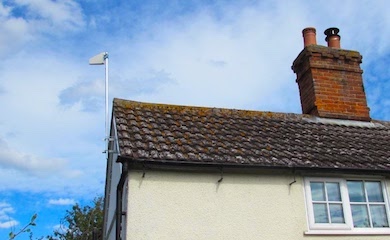Download the First Edition of our Telecommunications White Paper PDF here.
Parts 1 and 2 of this series presented a refresher course in dealing with wind farm and point-to-point telecommunications issues, and a recap on understanding the interference mechanisms. Part 3 of this series presents a photographic encyclopaedia of point-to-point communications infrastructure so that any developer may more easily identify potential site constraints.
Telecommunications Masts and Compound
Figure 1 below presents a fairly significant mast site at Winter Hill in Lancashire, UK, however most site are not as substantial. At a typical mast site, the following is present:
- The mast itself;
- A small utility building and/or a box containing the power supply and connection to the main network via a wire;
- A security fence.
Often signs will be present stating who operates the site, however this does not mean that they are the sole user of the mast, with many operators sharing mast infrastructure.
On the mast site in the photograph, you will see microwave and Ultra-High Frequency (UHF) dishes and receiving vertical antennas.
Figure 1: A foggy photo of the telecoms mast at Winter Hill.
Microwave Dish
In figure 2 below you will see two fairly standard microwave dishes mounted to a chimney. It is common that the dishes are white in colour. These dishes are directional meaning they are orientated in the direction of the corresponding link end. Microwave links also require radio line of sight to operate and therefore, depending on the dish height, it is possible that (on a clear day) you could see the corresponding link end, maybe with the assistance of binoculars. This does however depend on the length of the link path.
Figure 2: Two microwave dishes.
Ultra-High Frequency Transmitter
Figure 3 below shows an omni-directional UHF transmitter, often used for transmitting television services. Whilst this transmitter is not directional, the receiving aerials (shown in the following section) are. This means they need to be oriented towards the transmitter for optimum signal strength. There are also directional UHF dishes which look similar to the microwave dishes presented in the previous section, and again, it is common that they are white in colour. Due to their lower frequency, UHF signals do not necessarily need a direct radio line of sight to work appropriately.
Figure 3: UHF transmitting mast.
Ultra-High Frequency Receiving Antenna
As mentioned previously, UHF communications are typically used for television broadcast services. UHF communications are however also used by utility companies to co-ordinate and monitor their infrastructure. On this basis, the type of aerial used by many households for receiving television transmissions is the same as those used by utility companies at their infrastructure.
Figure 4 below shows a receiving UHF antenna (or aerial). This is not a transmitter and the aerial is only capable of receiving a signal. The orientation of the elements dictates whether it is set to receive a horizontally or vertically polarised signal. The separation of the elements also relates to the wavelength of the signal received.
Figure 4: UHF receiving antenna.
Summary
When locating a wind farm, it is a good idea to have an initial idea of the potential communications infrastructure that is present on or near to the site. Having a mast on site can cause significant constraints without detailed mitigation, and this could even include having to lose one or more wind turbines from the scheme, as a worst-case. That being said, as the signals are wireless, you will not be able to fully understand how busy the airspace above a site is with wireless communications infrastructure. Therefore consultation is key, and this process is discussed in the next article in this series.
Additional Resources
Further information on communications issues surrounding wind farms can be found in the following articles:
- Refresher Course in Wind Farms and Point-to-Point Telecoms Issues – Part 1 – Overview
- Refresher Course in Wind Farms and Point-to-Point Telecoms Issues – Part 2 – Interference Mechanisms
- Communications planning issues for wind turbines
- What is a Fresnel zone
- Wind turbine terrestrial television interference
Click here to read the next article in this series, which will investigate the consultation and assessment process for telecommunications.
About Pager Power
Pager Power undertakes technical assessments on behalf of developers, which include assessing whether a proposed development infringes instrument flight procedures and would cause a problem for said technology. For more information about what we do, Please get in touch.
References
[1] Sam Forson, March 30th 2017 on Pexels.com. Last accessed on 27th July 2022. Available at: https://www.pexels.com/photo/three-gray-wind-turbine-243138/







